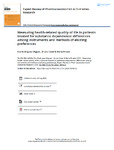Mostrar o rexistro simple do ítem
Measuring Health-Related Quality of Life in Patients Treated for Substance Dependence: Differences Among Instruments and Methods of Eliciting Preferences
| dc.contributor.author | Rodríguez-Míguez, Eva | |
| dc.contributor.author | Casal, Bruno | |
| dc.contributor.author | Rivera, Berta | |
| dc.date.accessioned | 2024-01-12T15:43:41Z | |
| dc.date.issued | 2021 | |
| dc.identifier.citation | Eva Rodríguez-Míguez, Bruno Casal & Berta Rivera (2021) Measuring health-related quality of life in patients treated for substance dependence: differences among instruments and methods of eliciting preferences, Expert Review of Pharmacoeconomics & Outcomes Research, 21:4, 683-690, DOI: 10.1080/14737167.2020.1804872 | es_ES |
| dc.identifier.issn | 1473-7167 | |
| dc.identifier.issn | 1744-8379 | |
| dc.identifier.uri | http://hdl.handle.net/2183/34885 | |
| dc.description.abstract | [Abstract] Background: Measuring the health-related quality of life is an essential estimation in cost–utility studies. In this research, we provide new evidence about comparing utility scores – in the field of substance dependence. Although the main objective is to compare the EQ-5D-5L and SF-6D with paired gamble, evidence about the SF-6D with standard gamble is also provided. Methods: Ninety-four patients with substance dependence were recruited; the SF-6D and the EQ-5D-5L were administered at the beginning of treatment and 6 months thereafter. Differences in treatment effect were estimated by comparing utility gains. All analyses were reproduced for two subgroups of severity. Results: Both the baseline scores and the treatment effect are sensitive to the instrument used. For severe states, the SF-6D with paired gamble (SF-6D with standard gamble) estimates the lowest (highest) utility. With regard to the impact of treatment, the EQ-5D-5L and SF-6D with paired gamble estimate strongly similar effects for severe states (and both estimate greater effects than does the SF-6D with standard gamble). Conclusions: These findings have implications for cost–utility analyses. The incremental cost-utility ratio of treatments intended for severe states is barely sensitive to the choice of EQ-5D-5L or SF-6D with paired gamble. | es_ES |
| dc.description.sponsorship | This study was funded by the Spanish Ministry of Health, Social Services and Equality [Grant no. 2013I027] and by the Spanish Ministry of Science, Innovation and Universities and FEDER [Grant RTI2018-099403-B-I00] | es_ES |
| dc.description.sponsorship | Ministerio de Sanidad, Servicios Sociales e Igualdad; 2013I027 | es_ES |
| dc.language.iso | eng | es_ES |
| dc.publisher | Taylor & Francis | es_ES |
| dc.relation | info: eu-repo/grantAgreement/AEI/Plan Estatal de Investigación Científica y Técnica y de Innovación 2017-2020/RTI2018-099403-B-I00/ES/ESTUDIOS EMPIRICOS DE ECONOMIA INDUSTRIAL Y ECONOMIA DE LA SALUD. APLICACIONES CON DATOS MICROECONOMICOS | es_ES |
| dc.relation.uri | https://doi.org/10.1080/14737167.2020.1804872 | es_ES |
| dc.rights | © 2020 Informa UK Limited, trading as Taylor & Francis Group | es_ES |
| dc.subject | EQ-5D-5 | es_ES |
| dc.subject | SF-6D | es_ES |
| dc.subject | Paired gamble | es_ES |
| dc.subject | Standard gamble | es_ES |
| dc.subject | Substance dependence | es_ES |
| dc.subject | Quality of life | es_ES |
| dc.title | Measuring Health-Related Quality of Life in Patients Treated for Substance Dependence: Differences Among Instruments and Methods of Eliciting Preferences | es_ES |
| dc.type | info:eu-repo/semantics/article | es_ES |
| dc.rights.access | info:eu-repo/semantics/embargoedAccess | es_ES |
| dc.date.embargoEndDate | 9999-99-99 | es_ES |
| dc.date.embargoLift | 10007-06-07 | |
| UDC.journalTitle | Expert Review of Pharmacoeconomics & Outcomes Research | es_ES |
| UDC.volume | 21 | es_ES |
| UDC.issue | 4 | es_ES |
| UDC.startPage | 683 | es_ES |
| UDC.endPage | 690 | es_ES |
| dc.identifier.doi | https://doi.org/10.1080/14737167.2020.1804872 |






